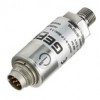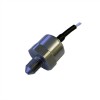 There are many types of materials used for constructing pressure sensors in a variety of applications, but those made from stainless steel are considered the most reliable and durable.
There are many types of materials used for constructing pressure sensors in a variety of applications, but those made from stainless steel are considered the most reliable and durable.
High Tensile strength
In hydraulic applications where pressure overloads are commonplace a stainless steel pressure sensor can withstand a high number of pressure cycles without fatigue damage.
Durability and Hardness
In demanding environments a high reliability and durability is required to withstand the extremes of shock, vibration and temperature. An all stainless steel design is ideal for these applications due to its high toughness.
Corrosion Resistance
For the majority of fluids and gases, stainless steel provides excellent protection against short and long term corrosion due to a naturally occurring resistant surface layer formed by a self passivisation process.
Welded Seals
Over many pressure and temperature cycles an all welded mechanical assembly provides a high integrity pressure seal for very high pressure and vacuum measurement applications.
Cleanliness and High Purity
For food, beverage and pharmaceutical industries, stainless steel is the preferred material because of its high polished surface which makes it easy to clean and discourages bacterial growth during use. The other benefit is that all the mechanical piece parts exposed to the media can be made from one material and welded together so that there are no crevices to attract contaminants or process media residues.
Types of Stainless Steel used in Pressure Transducer design
Whilst examining the suitability of materials used in the construction of a pressure transducer you will notice that different grades of stainless steel are used for the parts exposed to the pressure media. The choice of which stainless steel to use in a design is dependent on the required material strength, toughness, ease of manufacture, and corrosion resistance.
Stainless steel is a family of corrosion resistant iron alloys which have a Chromium (Cr) content of at least 10.5%. When exposed to Oxygen (O) either in the atmosphere or process media a self passivation process forms a surface layer which is corrosion resistant. The passive surface layer will naturally maintain itself over the life of the material.
There are 5 main groups of stainless steel which are Ferritic, Martensitic, Austenitic, Duplex and Precipitation-Hardenable Martensitic.
Ferritic Stainless Steel
The ferritic type of stainless steel is ferro-magnetic, and cannot be hardened by heat treatment due to the low Carbon (C) content.
430
430 is a low cost stainless steel but has limited properties to other types with less corrosion resistance, lower strength, poorer weldability and toughness. 430 is used in lower cost assemblies of pressure transducers and used in the construction of electromechanical components such as sensing diaphragms.
Martensitic Stainless Steels
These are similar to Ferritics but have a higher Carbon proportion which allows them to be strengthened by heat treatment. This type is not commonly used in the manufacture of pressure transducers.
Austenitic Stainless Steel
These are the most common group which are widely available offering good all round performance with workability and weldability. Similarly to Ferritics they cannot be hardened by heat treatment but the addition of Nickel into their chemical compositions increases the toughness:
303
303 is the most easily machinable of this type due to the inclusion of Sulphur (S) in the chemical composition. The main disadvantage however is that corrosion resistance and toughness are lower than other steels in this group. 303 is used for making fittings and manifolds, and is not generally used for thinner elements such as sensing diaphragms.
304
304 has a higher corrosion resistance than 303. It also has excellent forming and welding characteristics making it the most popular out of all the stainless steel types. 304 is used for components exposed to pressure media and formed parts such electronic housings.
316
316 is more corrosion resistant than 304 due to the addition of Molybdenum (Mo). In particular it is more resistant to crevice corrosion and pitting. This extra corrosion protection along with its good weldability has made 316 a popular material for marine applications. SS 316 is used in the manufacture of thin diaphragms for sensing elements and other pressure side components to improve compatibility with more aggressive media.
316L
316L has a lower carbon content than 316 which improves the resistance of welds to corrosion. Where there are welded components exposed to the media, using SS 316L will improve the protection of the weld to corrosion.
316Ti
316Ti is typically used in Germany and has similar properties to 316L but weld decay is prevented by the inclusion of Titanium (Ti) rather than the lowering of Carbon content.
Duplex Stainless Steels
These are a mixture of Ferritic and Austenite types which produces a stronger steel than either type whilst retaining high weldable and forming properties. The most important benefit of Duplex is its enhanced protection from corrosion cracking. Duplex materials tend only to be used in special applications such as offshore oil production where there are high levels of pressure being measured with highly corrosive media.
Precipitation-Hardenable Martensitic stainless steels
These are heat treated via the precipitation hardening process which enhances their strength considerably over normal martensitic types.
17-4PH
17-4PH has a high strength and toughness with similar corrosion protection to 304. The type of steel can be used in the manufacture of sensing diaphragms and pressure containment components particularly with high pressure applications but offers limited corrosion protection.
Glossary of Pressure Sensor technical terms
- Ceramic Pressure Sensors
- Digital Compensation
- Dry Cell
- Dry/Dry
- HART®
- Isolation Diaphragm
- LVDT – Linear Variable Differential Transformer
- Pressure Sensors
- SOI – Silicon on Insulator
- Static Line Pressure
- Wet/Dry
- Wet/Wet
Help from Pressure Sensor resources
- Pressure Sensor Accuracy Specifications
- Supply voltage and load resistance considerations for pressure transmitters
- How to Connect a 4-20mA Current Loop Pressure Transmitter
- What is difference between working, burst and over pressure
- What can a DP sensor be used to measure beyond differential pressure?

